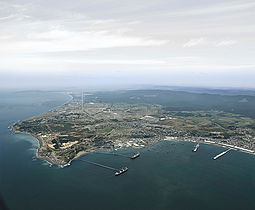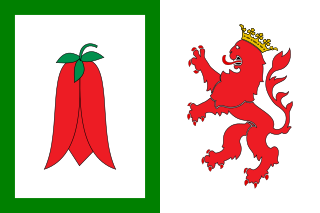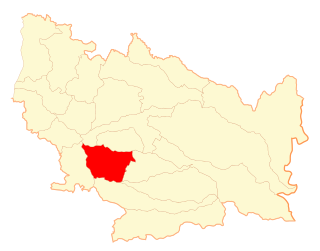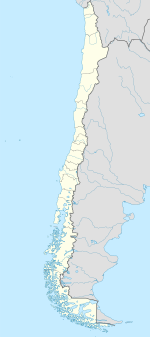
Los Ángeles is the capital of the province of Bío Bío, in the commune of the same name, in Bío Bío, in the center-south of Chile. It is located between the Laja and Biobío rivers. The population is 186,671 inhabitants. The municipality ("comuna") of Los Ángeles has the highest absolute rural population of any Chilean municipality.

Cañete is a city and commune in Chile, located in the Arauco Province of the Biobío Region. It is located 135 km to the south of Concepción. Cañete is known as a "Historic City" as it is one of the oldest cities in the country. The Battle of Tucapel and Pedro de Valdivia's death happened near the city's current location. Cañete was also an important location in the Arauco War.

Arauco Province is one of three provinces of the Chilean region of Bío Bío. It spans a coastal area of 6,366 km2 (2,458 sq mi) just south of the mouth of the Biobío River, the traditional demarcation between the nation's major natural regions, Zona Central and Zona Sur. The province originally covered the once-independent indigenous territory of Araucanía, but this was afterward divided into four provinces. It is devoted largely to agricultural pursuits. The capital Lebu is situated on the coast about 90 km (56 mi) south of Concepción with which it is connected by rail.

Coronel is a Chilean city and commune, located in the Concepción Province of the eighth region of Biobío.

Mulchén is a city and commune in Bío Bío Province of Bío Bío Region, Chile. It was first settled in 1871 by soldiers during the so-called Pacification of Araucania. In 1875 Mulchén was officially founded.

Claudio Huepe García was a Chilean politician, engineer and economist, member of the Christian Democrat party, who occupied several government and political positions. During his career, he was the provincial governor of Arauco, a member of the Chilean Chamber of Deputies, a government minister, and the Chilean ambassador to Venezuela. He was also among the first in his party to reject the 1973 coup by Pinochet and was exiled by the military dictatorship from 1975 until 1984.

Lota is a city and commune located in the center of Chile on the Gulf of Arauco, in the southern Concepción Province of the Biobío Region, 39 kilometres (24 mi) south of Concepción, and is one of the ten cities (communes) that constitutes the Concepción metropolitan area. The city is mostly known for being the traditional centre of coal mining in Chile, although mining ended in the 1990s.
Tucapel is a town and commune in the Bío Bío Province, Bío Bío Region, Chile. It was once a region of Araucanía named for the Tucapel River. The name of the region derived from the rehue and aillarehue of the Moluche people of the area between the Lebu and the Lleulleu Rivers, who were famed for their long resistance to the Spanish in the Arauco War. Tucapel is also the name of a famous leader from that region in the first resistance against the Spanish mentioned in Alonso de Ercilla's epic poem La Araucana. Formerly belonging to the Ñuble Province, in the Yungay Department. Near the town of Tucapel is the Plaza de San Diego de Tucapel. The capital of the commune is the town of Huépil, moving the municipality from Tucapel in 1967. In Mapudungun the name Huépil means "To seize or to take by force".

Arauco is a city and commune in Chile, located in Arauco Province in the Bío Bío Region. The meaning of Arauco means Chalky Water in Mapudungun. The region was a Moluche aillarehue. The Spanish settlements founded here during the Conquest of Chile were destroyed on numerous occasions by the Mapuche during the Arauco War.
Lumaco is a town and commune in Malleco Province in the Araucanía Region of Chile. Its name in Mapudungun means "water of luma". Lumaco is located to 120 km (75 mi) northeast of Temuco and 52 km (32 mi) from Angol. It shares a boundary to the north with the communes of Purén and Los Sauces, to the east with Traiguén and Galvarino, to the south with Cholchol and Carahue in Cautin Province, and the west with Tirúa and Contulmo in the Arauco Province of the Biobío Region.

Tirúa is a Chilean commune and town in Arauco Province, Biobío Region. The 2010 Chile earthquake led to a permanent uplift of Tirúa of about 180 cm above sea level, the highest recorded uplift related to the earthquake. This caused a large islet to form at the mouth of Tirúa River next to the town. The Misión Jesuita Mapuche is based in Tirúa.

Contulmo is a Chilean town and commune in Arauco Province, Biobío Region. Colonized by Germans of Berlin since 1884.
Curanilahue is a Chilean commune and city in Arauco Province, Biobío Region. Its name comes from Mapundungun "Cura", meaning "Stone", and "Nilahue" meaning "Ford".
Los Álamos is a Chilean commune and city in Arauco Province, Biobío Region.

Bulnes is a Chilean city and commune in Diguillín Province, Ñuble Region.
Pemuco is a Chilean town and commune in Diguillín Province, Ñuble Region.

Lebu River an important river of the Arauco Province in Chile. It has his sources in the western slope of the Nahuelbuta Range to the east of the city and port of Lebu, capital of the province and named for the river.

Santa Bárbara is a Chilean city and commune in Bío Bío Province, Bío Bío Region. In 2004 a great portion of its territory was taken off to form the new commune of Alto Bío Bío.
Quilaco is a Chilean town and commune located in the Bío Bío Province, Bío Bío Region. The commune spans an area of 1,123.7 km2 (434 sq mi).
Quilleco is a Chilean town and commune located in the Bío Bío Province, Bío Bío Region.

















